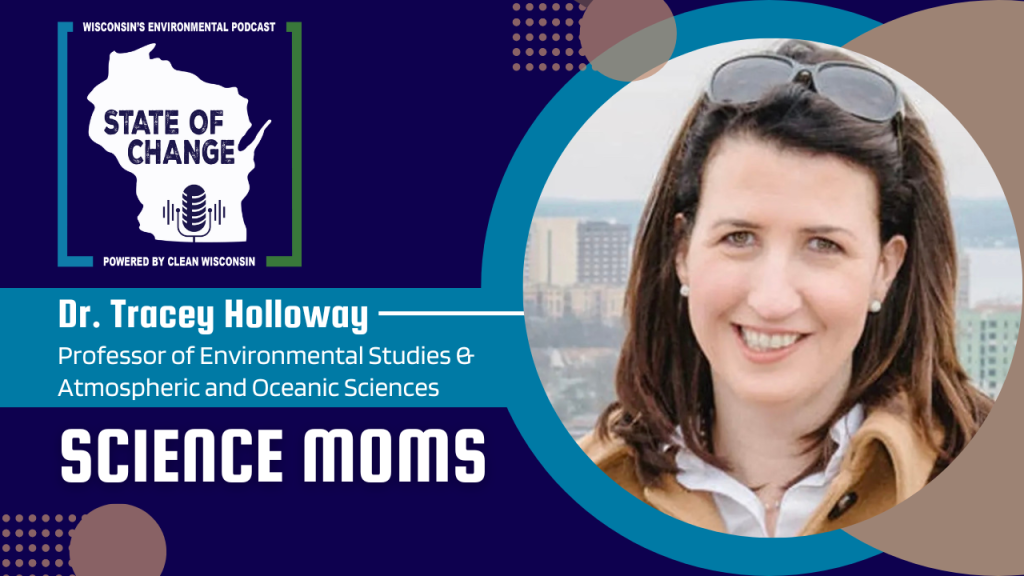How do you get people to start paying attention to the urgency of climate change? Just like the name says, Science Moms is a growing non-partisan group of scientists and mothers who are spreading the word about our climate and joining forces to demand change from our leaders. Amy talks with UW Madison professor Dr. Tracey Holloway, who is a member of Science Moms.
Host:
Amy Barrilleaux
Guest:
Tracey Holloway, Professor of Environmental Studies & Atmospheric and Oceanic Sciences at the University of Wisconsin, Madison; Science Mom
Background Reading:
Wisconsin Agriculture’s Critical Role in Addressing Climate Change
New Energy Study Shows Net-Zero Emissions Possible for Wisconsin by 2050
Federal Funds for Wisconsin: Take advantage of sweeping federal investments in clean energy and efficiency
Where to Listen:
Transcript:
Amy: Maybe you’ve seen the ads. Video of devastating fires and storms promoting the hashtag #lateristoolate. Or children struggling to breathe because of air pollution. The hard hitting videos are part of a major campaign from Science Moms. But who are the science moms, and what’s the goal? I’ll talk with a real life science mom here in Wisconsin to find out. I’m Amy Barrilleaux, and this is State of Change from Clean Wisconsin. How do you get people to start paying attention to the urgency of climate change? Maybe it starts with listening to your mom. Just like the name says, Science Moms is a growing, nonpartisan group of scientists and mothers who are spreading the word about our climate and joining forces to demand change from our leaders. Joining me is UW Madison professor Dr. Tracey Holloway, who is a member of Science Moms. First, what do you do in your Non-science Moms Day life at UW Madison?
Tracey: Yeah, I’m a professor at in the Nelson Institute for Environmental Studies and in the Department of Atmospheric and Oceanic Sciences. So I teach, I do research. I serve on committees. I edit papers, things like that.
Amy: So you’re a scientist then, basically. What made you think, okay, I want to get involved with this effort called Science Moms?
Tracey: I was approached by a good friend of mine, who is a leading national figure on climate change named Katharine Hayhoe. And Katharine was one of the first people that the Science Moms effort, kind of congealed around. And, Katharine and I have talked over the years of a lot about science and also about being moms. So I think she had suggested my name as one of the people to be involved. And knowing that Katharine was part of the effort and hearing that it was intended to be a nonpartizan, education, outreach, awareness building activity. I felt that it was in line with what my goals are as a scientist, as a, public employee, as an educator. And I also thought it sounded like a fun new way to connect with an audience that I care a lot about in my personal life, which is other parents.
Amy: So when I told coworkers I was going to talk to you about Science Moms, you know, a lot of the, female coworkers were like, oh, yeah, but a lot of the men less so, were less familiar with what Science Moms is. So how do you explain to people what Science Moms is about?
Tracey: So Science Moms is a major climate education and outreach initiative intended to bring information in a nonpartisan way to an audience that has been underserved in other science climate outreach initiatives, namely moms. And the focus on moms–it’s not just moms, we’re happy to appeal to anybody, parents, kids, and everybody has a mom. So, but I think that by framing it around an audience like moms, we can hit on a few issues that are not always part of the narrative on climate and climate solutions. And one of those is, what does this mean for our kids? Because everybody who’s a mom and, you know, of course, parents, grandparents, is thinking about what they can do today to make, life better decades from now. You know, when we went to visit, I, we I have a teenager and a toddler, and, you know, our teenager got braces recently and talking about what are the benefits of braces. Well, one of them is, you know, long term better health for your teeth. And when you’re thinking about what to feed your baby. A lot of it is, you know, what are the risks of developing diseases decades down the road? So moms are thinking about what’s going to happen in 2050 all the time. Like 2050 for us is like tomorrow. And, and we’re also making a lot of decisions at our homes, about, you know, the appliances and cars and stoves and heating and just thinking about the household as a functioning system that has a lot of big decisions that map on to the energy transition and our energy issues. So both as consumers and as forward thinkers and as people who are kind of aware of, how decisions today can affect tomorrow, I think that was one of the reasons why, the Science Moms initiative decided to focus on moms. Yeah. I would also say that it is the second largest climate education and initiative since Al Gore’s Climate Reality Project. So it is reaching a lot of people and a lot of eyes on their ads and the website and social media and, you know, it’s exciting to feel like my work is being amplified by the investment that the science moms have been making in this program.
Amy: In the United States, climate change is a little bit of a lightning rod issue. It’s kind of controversial. In fact, you know, as someone who communicates about climate change, I get told from folks, well, people don’t want to hear climate change. They don’t want to hear those words. How can we talk about climate change without without saying climate change? Or how can we talk about these other factors related to climate change and get people to be a part of the solution without kind of feeling like it’s about climate change. So when you are part of this effort, the Science Moms effort, that’s totally about communicating about climate change, why do you feel like it’s important to really talk about that issue, the changing climate, as opposed to kind of all these other kind of peripheral things around climate?
Tracey: Well, first, I would say I’m happy to talk about these issues and call them whatever people want to call them. I’m happy to talk about, electric cars. I’m happy to talk about air quality, about our kids’ health., extreme weather. I don’t think the labels need to be polarizing. I think we’re all looking out the window, and we’re all planning, what to wear on a day and seeing what we should structure our kids activities to be for the summer. So whatever we want to call it, you know, I’m not, I’m fine talking to people in whatever terms they want. That said, there’s something about, if you avoid talking about a topic, then it just becomes more polarized and more of a hot button issue. And when it comes to solving a big problem, how can we solve it if we’re not talking about it? So, you know, the Science Moms program has developed about a year ago, they developed the sort of three step to do list for solving the climate challenge. And, you know, their three steps are one to swap, appliances, cars. Like when you’re making a big investment, that is the time to be prioritizing, you know, energy savings. Two is to share just to talk about it like we’re doing right now. And three is to speak up that when it comes time to be voting in elections or to be, you know, making decisions on behalf of your school board or other kind of things, like letting your voice be heard in decision making processes. And so I think this idea of the swap, share, speak up, three step plan, really two of those are having to do with talking about the problem and talking about solutions. And, I think, you know, a lot of people are so focused on like recycling or turning out the lights, and those are all really good things to do. But the most important thing really, we can do is come together as a collective, because these are bigger problems than any of us can solve by ourselves.
Amy: You talk about big problems. I mean, it’s almost, overwhelming. It’s it’s a lot to talk about climate change. And I think that makes communicating about it real hard. Sometimes, people push it off and feel like, well, this doesn’t have anything to do with me right now. I can’t do anything about that. So in your professional life here at UW Madison, you look at a piece of a climate change cause. Tell me about the work that you do and how it intersects with people’s everyday lives and climate change.
Tracey: Yes. My research really focuses on air quality, the chemicals in the air that affect our health, that affect visibility, that affect crop production. And these chemicals in the United States have been regulated under the Clean Air Act since 1970. And so actually, you know, one of the reasons I like working on air quality is because it’s getting better and better. Asterisk. There has until last summer here in Wisconsin with the wildfires, which are setting us way back in terms of our air quality issues. But in terms of human caused air pollution in the United States, it is an ongoing success story. And, the reason it’s a success story is because back in 1970, the Clean Air Act was instituted. And right away, a problem that had been getting worse started getting better. We turned the corner on air pollution in 1970. Another example where we turned the corner that people have heard of is the ozone hole over Antarctica that was discovered in 1985. And in 1987, we had a global binding treaty on the books called the Montreal Protocol. We still have an ozone hole that forms every year, but the solution is in place. We’ve turned the corner. It’s getting better. And so when I think about climate change, it’s not a matter of snapping our fingers and saying the solution is done, but it’s a matter of turning the corner. And in fact, we are reducing our national carbon emissions slowly. But I would like for my kids to look back on the 2020s as the time that we turned the corner on climate change, just like we look back on the 1970s for air quality in the 1980s, for the ozone hole. The solutions are out there. And, you know, part of the part of the challenge is just getting started on the solution. It doesn’t mean that we have to wrap it up in the next couple of years.
Amy: You sound like a very optimistic person. And that’s that’s great. And you seem like the perfect science mom because you kind of speak with this, this optimism. Does it ever feel like, you know, we are just–we don’t have a lot of time. And, climate change is one of those topics that people kind of don’t want to talk, about or want to think about all the time. How do you kind of keep that, that optimism in this space? [00:11:08][25.1]
Tracey: I am optimistic when I look and see how far we’ve come. Even in the 25 years that I’ve been working in science. I remember when I was a graduate student in the 1990s, even I remember I was opening an account at a bank, and the bank teller heard that I was an atmospheric scientist and said, so, do you believe in climate change? You know, that was, everybody used to ask, do you believe in climate change? Nobody really asks that anymore. I think that climate change people know is happening. They can see it. They are aware that the science is pretty settled. And now it’s a question of what should we do about climate change? And certainly, I still get into conversations, about, you know, should we do anything like maybe, maybe this is all a good thing for the environment, you know, and, and I think that the that certainly, you know, reasonable people can disagree on what to do. But the idea that it’s, that one we are we are reducing our national carbon emissions, not fast enough. We are seeing a growth in zero emitting vehicles, zero emitting appliances, zero emitting energy systems. Like renewables are a much bigger deal than they ever have been. And here in Wisconsin, our local I mean, here in Madison, our local utility, Madison Gas and Electric, is on a path to be net zero by 2050. And they’re actually exceeding their, their, their reductions along that path. So I do see reasons to be optimistic. That doesn’t mean, though, that there isn’t work to be done. And if there wasn’t work, if there was no work to be done, then we wouldn’t be having this conversation. So, you know, I think that, that making people aware that this is a solvable problem, that we are moving in the right direction, just not fast enough, and that we can solve climate change without changing our world upside down. And in fact, if anything, what’s going to change our world upside down is not taking action to solve climate change. I think everybody’s very focused on, well, what will this mean for me? And we’ll have to move out of my house or, you know, change the, the, the life that, that, my kids are going to have. And the truth is, I think if we want to give our kids something similar to the lives that we had growing up and that our parents had growing up, we have to be moving these conversations forward. One of the things that I like working with the Science Moms program is that we have these, like, really talented communication professionals, behind us. And they, are coming out with these advertisements. And that’s how a lot of people have heard about Science Moms through TV advertisements or online advertisements. And, one of their current programs is called In Memoriam, where they’re profiling all the places that used to exist that don’t exist anymore. And maybe they don’t exist because they were flooded or because they melted, or because it’s too hot to go there or, you know, here in Wisconsin, we used to have a lot of snow days in the winter, and now we just don’t have that many snow days. I mean, I remember when I first moved here, I was about to get cross-country skis and then, you know, I kind of delayed it and delayed it. And now, there’s only a couple days each winter, really, that are appropriate for cross-country skiing in Madison, or at least for the past few years. So, you know, I think this idea that things are changing and that there are solutions available, is, you know, to me, there’s a good news story there buried in the bad news story.
Amy: So people listening to this or thinking, well, I’m a mom or dad or just a person and I want to get involved. How do you get involved with Science Moms? And I guess, what has – you outlined the three goals, but what is it like to be a science mom?
Tracey: So the Science moms.com is a website, that you can go to, and they have a mailing list and a way to sign up. They have, local affinity groups that people can join and be part of. But really, I think that, a lot of it is about, you know, getting access to information that can empower you to feel like you know the facts and that you know the issues, so that you can talk in your communities and take actions that make sense for where you are. A few, one of the initiatives that Science Moms was pushing earlier this year was to support schools transitioning from diesel busses to electric school busses. And the rationale here is, first of all, with the the Inflation Reduction Act, there’s a lot of money to move toward electric vehicles and clean energy. So this is a great time to be making those big investments, whether it’s on behalf of a family, in a household, or on behalf of a school or a community. But also that when we move to electric vehicles, it’s good for climate because we’re not burning that diesel fuel that goes into the atmosphere and lasts. The CO2 in the atmosphere stays there for 100 years or more. But also, when we’re burning diesel fuel, it’s emitting nitrogen oxides and particulate matter and cancer causing chemicals, that are bad for our kids. And who’s riding the school busses and waiting at the bus stop and in front of the schools but the kids. So something like switching from a diesel vehicle to an electric vehicle is a great example of these win-win solutions that, it is good for climate, good for air pollution, good for our kids health. And, you know, the bus is still a bus. I mean, I don’t really care. There’s no downside to having a bus be charged up as opposed to fueled up. As long as it’s getting my kids back and forth to school safely. So there’s just so many of these opportunities to address, to move the needle on climate to make our air cleaner and healthier, and really to be moving toward a solution. [00:17:26]
Amy: Tracey Holloway, UW Madison professor and real life science mom, thank you so much for talking with me about this and for all the work you do.
Tracey: Well, thank you so much. It’s been a real pleasure to be here with you.
Amy: For more information on climate change impacts here in Wisconsin, Science Moms, and what you can do to help, log on to our website CleanWisconsin.org. I’m Amy Barrilleaux and you’ve been listening to State of Change Powered by Clean Wisconsin.





